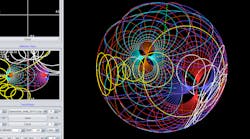Download this article as a .PDF
The Smith chart, which is unquestionably one of the most important and fundamental aspects of microwave engineering, has a long history that spans more than 70 years. However, one team of engineers decided to take the classical Smith chart and put a much different spin on it. The result is a 3D Smith chart tool, which the team says is a new vision in microwave analysis and design (see figure).
The 3D Smith chart tool is an easy-to-install 3D representation of the classical Smith chart that is intended for high-frequency one- and two-port circuits. It works for all passive and active circuits—even when negative resistance is present. With this tool, users can observe impedance/admittance, as well as stability circles, group delay, quality factor, and unilateral power gain.
The 3D Smith chart differs from the traditional Smith chart in a number of ways. For example, as most already know, the center of the classical Smith chart denotes a perfect match. However, the 3D Smith chart shows a perfect match at the north pole.
In addition, RF/microwave engineers already know that negative resistance (|reflection coefficient| > 1) cannot be shown within the confines of the traditional Smith chart. However, negative resistance is indeed portrayed in the 3D Smith chart. Specifically, the south hemisphere represents negative resistance, with the south pole denoting an infinite reflection coefficient. The north hemisphere of the 3D Smith chart represents positive resistance. Furthermore, the inductive region is designated in the east, while the capacitive region is represented in the west.
Moreover, the program interface includes rendering options, which allow users to select the desired displays. These displays include constant normalized resistance (r), reactance (x), conductance (g), and susceptance (b) circles. Users can also modify colors, as well as the step between circles.
Analysis and Design
Users can take advantage of both analysis and design modes. With analysis mode, a touchstone file can be loaded to allow one to view a number of parameters on the 3D Smith chart. These parameters include impedance, stability circles, constant gain circles, group delay, quality factor, and unilateral power gain. The S-parameters can also be represented on a 2D Smith chart.
Design mode enables users to obtain normalized matching circuit solutions. One can simply enter the desired normalized impedance parameters and then choose a matching route. The corresponding resistance, inductance, and capacitance values, as well as transmission lines and stubs, can be directly computed.

